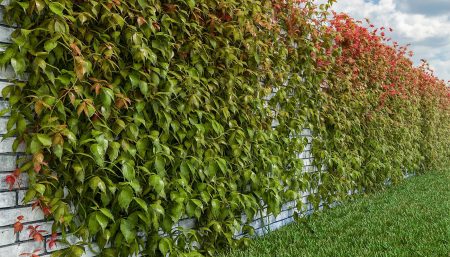
Owners of country houses strive to make their site the most beautiful, using a variety of beautifully flowering shrubs and vines for garden decor.
A good option may be a wild grape, which is a lush vine, which in two or three years after planting will cover the most plain tile or an old ugly fence.
Content
Description and characteristic
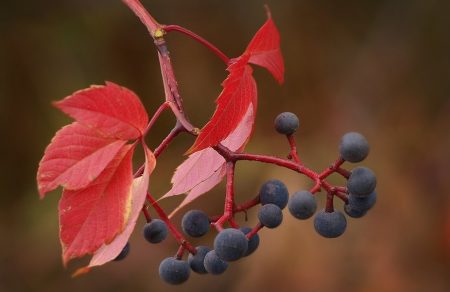
In suburban areas, wild grapes are very rare. Gardeners consider it active in overgrowing, as it is difficult to get rid of the roots. In addition, the fear that mice or rats settle in the lush foliage of the root zone of the plant discourages many from planting a vine in the plots. However, in addition to aggressive qualities, the plant has many advantages. And with proper care, the unpretentious liana will serve as a beautiful decoration of the garden.
Girl’s grape is a perennial vine that can withstand frosts down to -45 degrees without shelter, does not need abundant watering even in the most severe drought, propagated by all parts of the vegetative mass and seeds. It reaches a height of 5 m to 30 m. The foliage in the summer has a white-green or saturated emerald color, and with the onset of the first frost it changes to a cherry red hue. By the beginning of September, the liana forms a lot of brushes with small blue-purple berries, which waxwings and hempweed really like to feast on.
Grape stepsons, growing, use subordinate proximal roots that grow down from the stem and cling to the smallest bulges. At the tips of the sucker-roots of the milk are stomata, through which the plant releases the substance viscin. Thanks to him, the liana will attach even to the most even surface.
Wild grapes planted on a summer cottage will serve not only as natural decor on the plot. The plant will protect the building from getting wet - raindrops will flow down the leaves, leaving the walls dry. In addition, fences with a vine planted will protect the owners from excessive noise, dust and “prying prying eyes”. Planted grapes near the walls of a multi-storey building will provide residents with protection from the scorching summer rays of the sun.
Important!
The fruits of the plant varieties Amursky breakthrough and Virgin contain an increased amount of toxins. Therefore, their use in food will cause nausea, vomiting, fever.
Beneficial features
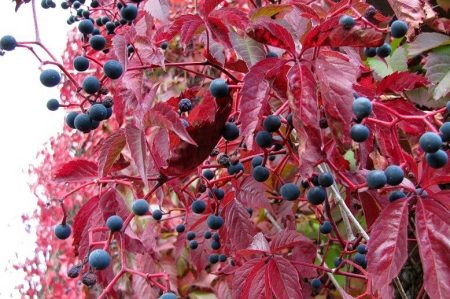
The taste of wild grapes is unpleasant, so they are not eaten. With pleasure, only house sparrows, blackbirds and lanes eat them in winter thaws. However, in pharmacology, the product has been successfully used to treat neoplasms and inflamed vessels. The young branches of the plant contain:
- plant-based antibiotic resveratol, which reduces inflammation and the risk of developing malignant neoplasms in the body;
- natural styrene, lowering the level of harmful cholesterol and lipids;
- saturated hydrocarbon heptacosan, which improves the functioning of the central nervous system;
- omega-3 lipids, which neutralize free radicals in the human body, improve heart rate and vascular status. Blood viscosity and blood pressure are normalized.
Wild grape varieties for planting on the site
Originators from England, where this plant is highly revered, work every year to develop new varieties of wild grapes. But the most common are ancient varieties imported to the continent from the coast of North America and Japan.
Thomson
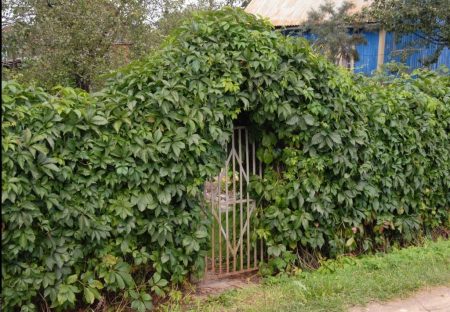
American variety, growing in length up to 3, 5 m. It withstands frosts without shelter up to -35 degrees. Last year's stems have a bark of gray-yellow color, young - green. After the onset of the first frosts, the usual green palm-folded foliage of an oval-shaped plant takes on a light plum hue. For the vines to grow well, vertical support is required.
Amur breakthrough
The most frost-resistant variety comes from Eastern Russia, withstanding temperatures without shelter up to -50 degrees. After its discovery by botanists about 60 years ago, he became the founder for the development of new varieties and hybrids of wild grapes. It has saturated green leaves, which from mid-September are painted in an orange-red hue. By the beginning of autumn, clusters of black-purple small berries ripen on the shrub, which look like an unusual beautiful decor.
Virginia
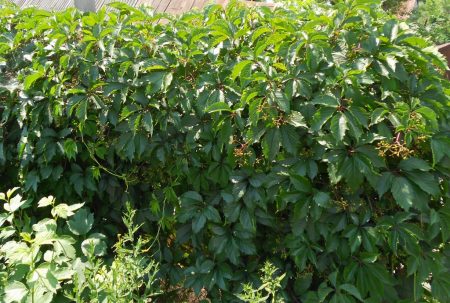
A powerful shrub reaching a height of up to 40 meters thanks to the additional roots with a sticky substance. It features active shoot growth and frost resistance without additional shelter up to -35 degrees. Within one season, stepsons grow by 3m-4m. The foliage of grapes resembles chestnut leaves, has a pointed oblong shape. In the summer months, the lianoid shrub is a high bright green wall, which by mid-September becomes red-cherry in color. It grows well in both sunny and shaded areas.
Henry
A miniature variety of wild grapes, reaching a height of only 2m-2.5 m. Without shelter it withstands frosts of up to -20 degrees, therefore it is often grown as a container or pot culture. Plants planted in flower pots grow well on balconies, with the onset of frost they are brought into the room. It has a decorative, rounded palmate foliage of light green color with whitish veins, which in autumn turns purple.
Star showers
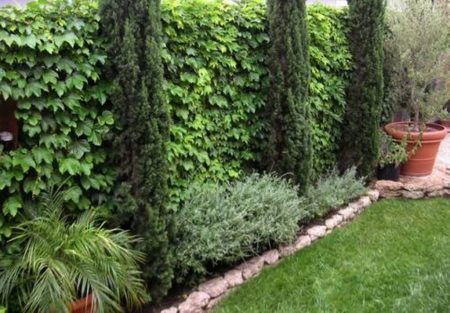
A decorative variety that is frost-resistant up to -28 degrees. It grows to a height of 20 meters, clinging to the support of the additional roots on the stem. It has small light green leaves with white specks of various shapes and sizes. After prolonged frosts, the foliage changes its color to lilac-red. Thanks to its unique natural veil, it looks very impressive.
Viche
A powerful lianoid shrub, the size of which reaches 25 meters in height. It withstands frosts without additional shelter up to -38 degrees. The variety has bright green shiny dense leaves, which in mid-September acquire a yellow-orange color. After the first frosts, the yellow foliage of Viche acquires a purplish-purple hue.
Parthenocissus hairy
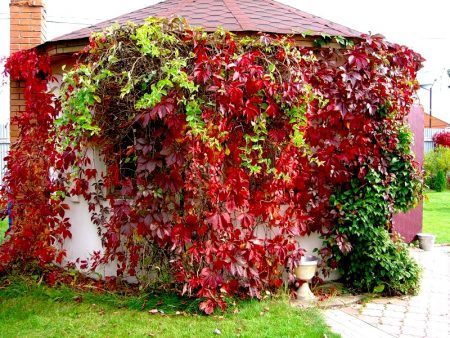
Grapes, which does not differ in increased winter hardiness and can withstand frosts without additional shelter up to -20 degrees. It grows in nature in Japan and the southwest of the Primorsky Territory. Liana, which retains its decorative effect throughout the season. It has dense shiny three-lobed leaves with a soft edge of bright green color. In early autumn, foliage turns orange-red.
Important!
When growing wild grapes, it is not recommended to use wooden props. Indeed, in conditions of humidity, the tree will quickly rot, break, and injure the plant.
Landing time
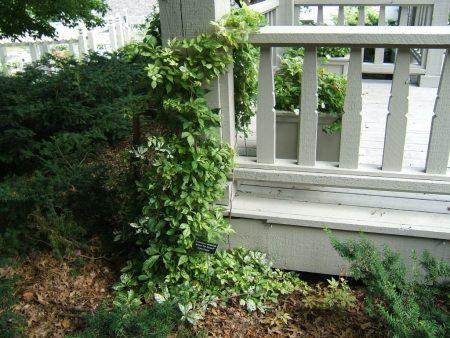
Decorative liana does not require special care and grows well both in shaded areas and in direct sunlight. The only thing that will distinguish plants planted in different places is the color of the foliage. In sunny areas, due to ultraviolet radiation, coloring pigments carotene and xanthophyll will appear in the autumn months.Therefore, from the beginning of September, leaves turn colored from golden-orange to a purple-purple hue. But in the shade in the leaves there is more chlorophyll, which gives them a green color.
You can plant grapes from early spring to late autumn, during any period of the growing season, the plant can take root well. However, gardeners recommend planting in mid-September. Young plants planted in early autumn will take root well before steady frosts, and the scorching May rays of the sun during spring planting will not harm the seedlings.
Important!
Biennial and three-year-old seedlings that have already taken root suction cups to any support cannot be transplanted. Separation from the base, for which the plants clung, will lead to the death of milk roots and grape disease, which for a long time will not be able to curl.
Landing methods
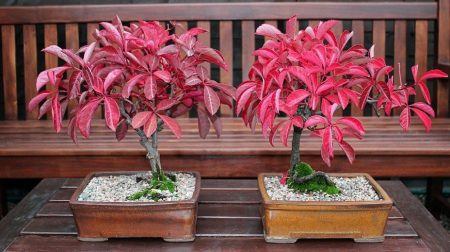
It is possible to propagate a tall curly perennial using several methods, and with its reproductiveness there are no difficulties even for beginners.
Cuttings and layering
In early spring, the Maiden Grapes produce good material for grafting.
For this:
- in mid-March, you need to choose intact one-year branches with a thickness of 0.8cm-1, 5cm;
- cut branches from a branch length of 20cm-35cm with the presence of 3-5 kidneys;
- fill the prepared containers with nutrient soil, pour water with the addition of activated carbon crushed into powder;
- plant the cuttings in spilled soil, leaving the upper bud, at an angle of 45 degrees, to compact the earth;
- place the containers on the windowsill, pour daily warm water with the addition of activated carbon until the rooting of the cuttings, which should occur after 35-45 days;
- after rooting, watering is halved;
- transplant the cuttings with the root system to a permanent place in the open ground.
Important!
You can plant grape cuttings immediately in the open ground. To do this, in mid-October, cut the segments and mulch them with a 30 cm organic layer. In spring, the material will grow roots.
Seeds
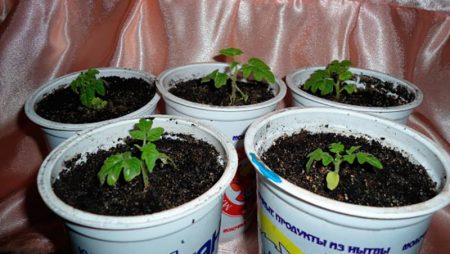
With the help of seed material, Wild grapes are usually bred only in nurseries. Since it is difficult to grow a plant on its own, creeper seeds need to be stratified, and the seedlings yield only 8% -10%. However, having patience, and at home from the seeds it turns out to grow grapes.
To do this, you need:
- prepare a saucer or a small plate, a piece of gauze;
- pour water into the dishes on the material, in which to dilute any growth stimulator;
- decompose prepared wild grape seeds on top of wet gauze;
- determine the material on the top shelf of the refrigerator, keeping it for 10 days. Check that the water in the plate does not evaporate and constantly add it;
- after stratification, put the saucer in a warm place for 5 days, and then again in the refrigerator for 7-10 days;
- after 25 days, seeds that bite up are planted to a depth of 1 cm in prepared nutrient soil;
- regularly emerge sprouted seedlings with warm water with the addition of a growth stimulator;
- to plant young seedlings in open ground in the last May decade after passing night frosts.
Propagation of wild grapes by root offspring
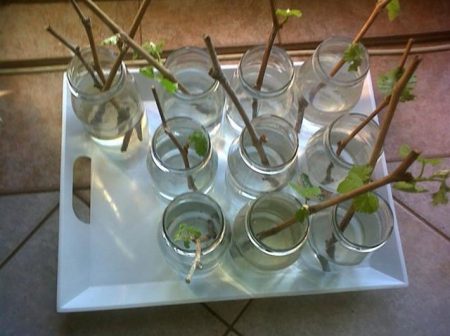
The shoots that grow at the base of the grapes may also serve as good material for plant propagation.
To do this, you need:
- in the first days of April, bend a growth of at least 60 cm high to the ground with a strong wire or wooden chopped wood chips;
- mulch the place of the clamp with grass or straw;
- the future shrub to be watered daily, preventing the soil from drying out;
- at the end of September, carefully bend the bent branch from the mother bush, transplant to a new place.
Important!
Low-growing and non-frost-resistant varieties that are cultivated in flower pots also propagate by shoots. To do this, put the prepared pot of soil next to the main one, fix the grape branch in it, constantly maintaining the soil moisture under the future seedling.
After landing care
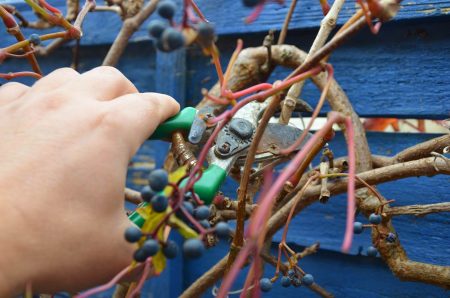
Further care for young seedlings is not difficult, since the plant is unpretentious and resistant to disease. However, if the vertical surface near which the liana will grow is even and smooth, an additional support should be arranged for the young seedling. And when the grapes take root well, he will be able to "climb" to the wall without any help. Throughout the season, after planting, carry out:
- watering once a week;
- two top dressings with complex fertilizer during the summer;
- mulching the soil under the seedling;
- pruning a very large vine.
Important!
For the winter, young seedlings should be carefully removed from their supports, laid on the ground, covered with agrofiber to prevent freezing of the buds.
Wild grapes in landscaping
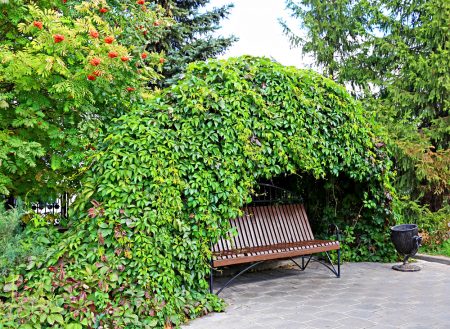
With the help of an unpretentious liana and a reliable support for it, you can create an amazing plant composition in a summer cottage. Once you see a beautiful hedge, you will immediately want to plant it to decorate plain walls or clumsy fences. In addition, it will be cheap, safe. And even the most rotten trees can be decorated with a vibrant colorful coverlet. You can apply wild grapes in the design of a summer cottage:
- in bonsai style, having grown a small copy of a tree, placing a flowerpot with miniature girl's grapes at the entrance to the house or near the altanka;
- planting a plant near ruined and ugly sheds, which after braiding with grapes will look like large green-red bushes;
- planting grapes near metal wicker nets, acting as fences. At the same time, the living wall will protect the owners from prying eyes;
- decorating a loggia or balcony, planting a plant in a bulk container;
- creating unique living arched structures at the entrance to the courtyard;
- Having planted ten seedlings of wild grapes around the perimeter of the house, create an original house surrounded by lush foliage.
Reviews
Summer residents who planted wild grapes on their plots share their impressions.
Gennady, Kiev.
Four years ago, I bought a cottage with my wife. However, my neighbor and I were not lucky - it’s very curious. The woman constantly tried to look out for something through the fence. That's when they decided to plant wild grapes for the entire length of the fence. Three years passed, the plant turned into a green wall, through which prying eyes can no longer break through.
Karina, p. Cacaclia, Moldova.
Grandparents left my brother and I inherited a small house, the restoration of which required a lot of money. Dilapidated sheds and a homely little house with which we did not know what to do, since both my brother and I were constantly working. A friend advised to plant everything with wild grapes. Three years later, our “inheritance” was simply not recognizable. The dilapidated buildings turned into fabulous living houses.
Wild grapes, unlike cultivated grapes, are unpretentious and easy to grow, can serve as a good protector from winds, rains and the sun.




 Non-covering winter-hardy grape varieties for Moscow region
Non-covering winter-hardy grape varieties for Moscow region How to keep the vine in winter
How to keep the vine in winter When can I transfer grapes to another place in the fall
When can I transfer grapes to another place in the fall How to cover and prepare grapes for the winter in the suburbs
How to cover and prepare grapes for the winter in the suburbs